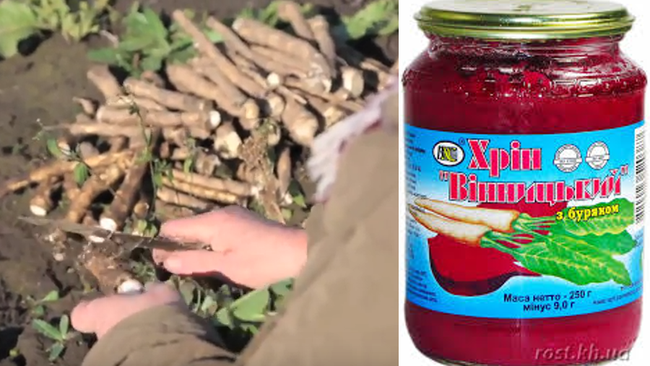Ukraine has potential for vegetable sector growth due to high global demand for fresh and prepared vegetables. However small farmers are focused on growing products for a different time. Horseradish, a common weed in Ukraine that is rarely harvested, could be a solution to break the cycle and show the potential of responding to market demand. Vinnytsya Food Factory, processor of horseradish, believed that by better organizing and expanding its supply chain it could reach scale to serve international markets and increase the income of rural families. The conundrum was how to convince farming families to plant and harvest a weed.
Recognizing that organizing inputs to process and meet market demand plays a key role in the core function of a market system, the project co-invested with Vinnytsya Factory in 2017 to address the issue. The processing factory specializes in producing sauces and condiments and is engaged with vegetable producing SMEs down the supply chain, building trustworthy and sustainable market linkages. The factory was facing supply disruptions for the key ingredient in its top-selling sauce, horseradish, which is mainly seen as a weed in Ukraine. The project worked with the factory to promote the building an organized input supply system through the cultivation of a highly productive horseradish variety. In Feb. 2018, Vinnytsya Factory started training its input suppliers, 12 SMEs and 1,500 private households, to plant a new cultivated horseradish variety. In Nov. 2018, the factory expects an increased horseradish harvest and no disruptions to its horseradish supply. The project plays a facilitative role through consultations and targeted investments into the partner's supply chain. The factory is closely monitoring the outcomes of this new business model, namely, increases in horseradish productivity, factory production volume, and exports.
Vinnytsya factory took on all ownership for organizing the input supply model focused on its supply chain bottleneck, i.e. the continuous supply disruptions and missing input suppliers for good quality horseradish. The factory is working directly with 12 SMEs to establish new horseradish cultivation in Vinnytsya region, and itself planted a new cultivated horseradish variety in autumn 2017 on 16 hectares. The factory organized a training series on new technologies in horseradish cultivation, and will support its SMEs down the supply chain with consultations during spring-autumn 2018. Vinnytsya also invested in modernizing its factory facility (60% company investment vs 40% ARDS co-investment) to prepare the processing factory for an input supply increase from the new agricultural practices. This input supply model is sustainable and will be used as a model for “crowding in” other enterprises looking to invest in their businesses with similar input supply models.
During project implementation, Vinnytsya factory faced 2 specific challenges. (1)The factory was lacking the proper technological processes for cultivating horseradish. As it is an absolutely new practice for such a widely-known weed plant as horseradish, the project found it challenging to identify a consultant on modern cultivation practices for horseradish. (2) The only variety of horseradish that was available in Ukraine was wild horseradish. Vinnytsya factory analyzed the most suitable horseradish varieties that could bring the highest harvest, and imported the seed-plant from Europe.
In Autumn 2018, the factory will evaluate the harvest increase, after adoption of full-cycle technological support from the consultant, to determine if the selected horseradish variety is the best for Ukrainian fertile soil.
As project implementation just began last year, the outcomes will be collected over the next three years and summarized in a guide on how to plant horseradish in Ukraine, “Practical guidance on horseradish cultivation modern technologies.” The project has compiled the knowledge gained from these challenges and is now adapting the process to replicate the input supply model for cabbage and bell-pepper in the eastern and southern regions of Ukraine.
Impact is measured from the different angles: behavioral change in adopting new models by input supply actors, and operational indicators for evaluating the output. The project's original indicators are used as key operational indicators for measuring project efficiency: number of farmers who have applied new technologies, % of productivity change, value of incremental sales, and value of agricultural commodities exported. Vinnytsya factory will disseminate this input supply model to private households in nearby villages, establishing horseradish as a source of additional income for rural residents. The most prominent change is turning a weed plant into a crop cultivated by 1,650 farmers implementing new technologies. Vinnytsya factory set an aggressive goal, as well, planning to double its 2016 revenue by 2019.
The initiative aims to build a new model for market relations (behavior change), when the processing SMEs work down the supply chain with input supply actors on planning the varieties for planting and harvesting, and pre-agreeing on the future input supply harvest to be purchased by the processor. This change will be measured as % of input suppliers that have pre-agreed their future harvest sales to the processor, from the current 33% SMEs to 65% in 2019.
The project will compile “Practical guidance on horseradish cultivation modern technologies” in autumn 2018, after the first-year agricultural cycle is over, to summarize the learning for further replication of this model by other SMEs.
The project and Vinnytsya Factory are partnering with two institutions on this project:
1) National Agrarian Academy (National University of Bio-resources and Natural Resources of Ukraine), to adopt global best practices on modern cultivation technologies for horseradish, trainings for SMEs, and consultancies during horseradish first-year planting.
2) Odessa National Academy of Food Technology, to develop new recipes for Vinnytsya factory using horseradish.
